DRIVING SUSTAINABILITY








IN NEW HAMPSHIRE
An integrated approach to resource management


Our shared vision for sustainability










An integrated approach to resource management


Our shared vision for sustainability

Most would agree that having trash disposed of in the most efficient and environmentally responsible way benefits everyone and everything, including our planet. That is precisely what Casella has been doing since the company was founded in 1975 and as a partner with customers and communities in New Hampshire for more than 30 years.


We have spent most of our 47-year history thinking about sustainability through the things we do, the infrastructure we build, and the expertise we bring to challenges like recycling and resource management. Now, our understanding of sustainability is calling us to reach further, and to set our sights more broadly on creating a sustainable business culture — from our people to our operations — and to create more sustainable value, especially for our customers and also the communities in which we operate. Responsible materials management has evolved over time and is built squarely upon four pillars, creating an integrated approach that we continue to effectively operate and improve today.
• Take it away. Since our founding, the most important job has been to keep neighborhoods clean and healthy by promptly and reliably removing waste.
• Divert waste and recover resources. Technology continues to enable additional waste diversion and energy recovery, such as recycling, which has played an important role in helping us manage scarce disposal capacity and renewing natural resources for 45 years.
• Fuel a circular economy and protect the planet. We all must play a part in helping to minimize waste, cycling resources back into supply chains, and dramatically cutting carbon emissions while creating real value for all stakeholders. A true circular economy exists at the intersection of economic and environmental sustainability, with shared value and risk throughout the supply chain.
• Ensure safe and secure disposal. Our role in managing waste at the bottom of the hierarchy has grown from closing local unlined and unsafe “dumps” and properly securing waste in engineered sanitary landfills, such as the one in Bethlehem, NH, to advancing energy recovery and finding a higher and better use for all material we manage at these facilities.
As long as people and businesses produce waste, there will be the need to dispose of it safely. The question is: “What’s the best way to accomplish that goal?”
This progression includes building the first recycling facility in Vermont in 1977, the initiation of a food waste collection in 1999 that became Casella Organics two years later, and the reduction of the company’s carbon footprint by 45% in 2010, which led to the company earning the 2012 EPA Climate Leadership Award for Excellence in Greenhouse Gas Management.
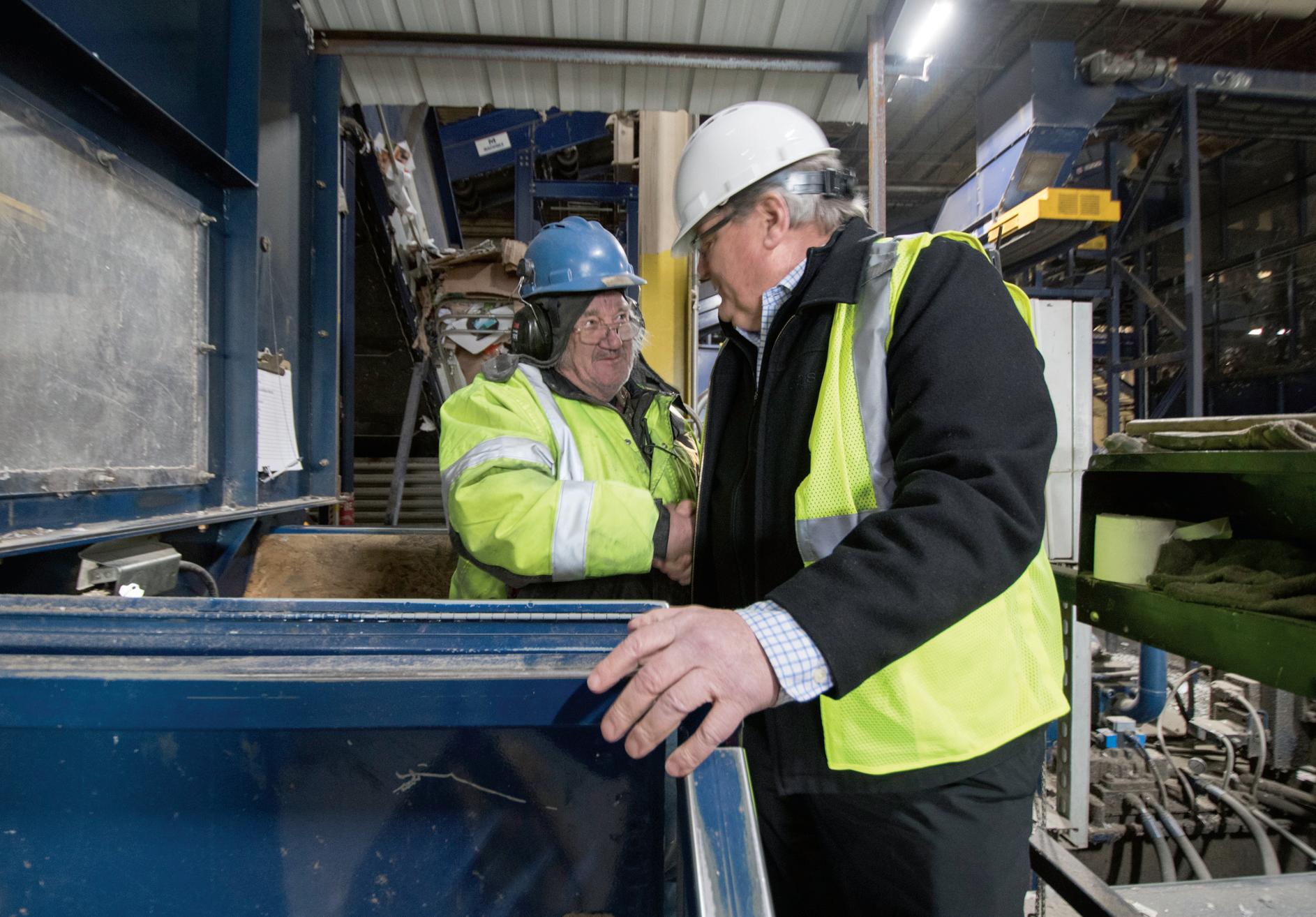
Sustainability is a journey without a destination. It is constantly evolving, and we have found that for nearly 50 years the best way forward is together. Our understanding of sustainability is calling us to reach further, and to set our sights more broadly on creating a sustainable business culture — from our people to our operations — and create more sustainable value for our customers and the communities we serve. As a result, we’ve established 10 sustainability goals that appear later in this publication and are strategically aligned to help guide us over the next decade.


CASELLA WASTE SYSTEMS, INC.
CHAIRMAN & CEO
“Sustainability is a journey without a destination. It is constantly evolving, and we have found that for nearly 50 years the best way forward is together.”
Casella operations recover more than one million tons from the waste stream annually and recycles or repurposes it for a higher and better use.

An Integrated Approach
The issues facing the waste and recycling industry are incredibly complex, with many interconnected parts. How does a company address all of them, while maintaining an economically and environmentally sustainable business?
That is the constant challenge facing Casella and the communities that the company serves.
While many people are paying closer attention to the products they purchase and the resources they consume, while simultaneously recycling more, modern society still requires safe, secure and affordable disposal options. In New Hampshire alone, Casella serves more than 50,000 households, 5,500 businesses, and 150 cities and towns through its collection, transfer, recycling and waste disposal operations. The company employs more than 175 people across its Granite State operations, with an annual payroll of more than $10 million, to manage more than 300,000 tons of New Hampshire waste and recyclables.
But Casella’s core operations are far more expansive, comprised of more than 140 facilities from Pennsylvania to Maine, allowing the company to deliver a full range of services to businesses, organizations and households throughout the region. With operations spanning the Northeast, Casella’s integrated resource management infrastructure connects its partners with the regional recycling and waste infrastructure needed to make modern life possible, while protecting the environment.
In short, this regional approach enables Casella to provide large-scale resource-management services at a cost that businesses and communities can afford and allows for local communities to share in the economic and environmental benefits of broader infrastructure capabilities.
To quantify the economic and environmental value that is created by this integrated system, Casella recently commissioned a study by DSM Environmental Services, Inc., an internationally recognized leader in data-driven analyses related to resource recovery and solid waste management solutions.
The study revealed some telling economic and environmental benefits to maintaining the current level of disposal capacity provided by the NCES Landfill in Bethlehem, in conjunction with a proposed Materials Recovery Facility (MRF) in central New Hampshire.
Key findings of the study include:
• The combined economic value of the landfill and recycling infrastructure is estimated to add over $400 million to the state’s economy over a 20-year period.
• In addition to the economic gains, it also allows New Hampshire residents and businesses to avoid nearly $75 million in additional waste and transportation costs over 20 years.
• An annual reduction of greenhouse gas emissions of more than 29,000 metric tons of carbon due to increased recycling rates and avoidance of additional transportation, which is equivalent to taking more than 6,200 passenger cars off the road each year.

With the cap and closure for the NCES Landfill in Bethlehem scheduled to occur at the end of 2026, Casella conducted a broad search for a suitable new site for a landfill to ensure that the needed capacity remained available. The company identified a suitable parcel on the outskirts of Dalton, situated in an industrial developed area with limited abutting neighbors.
The Granite State Landfill (GSL) being proposed for Dalton will be among the most technologically advanced in the industry and complements New Hampshire’s Waste Management Hierarchy, which prioritizes reducing trash creation while incorporating reuse, recycling and composting over landfilling.
According to Brian Oliver, Casella’s eastern region vice president, this disposal capacity is critical to bridging the gap to a future where landfills might be unnecessary. “Closing landfills while eliminating expansion of existing facilities and prohibiting the development of new facilities, does not stop the generation of trash. We all need to reduce, reuse and recycle to minimize disposal capacity needs, but in today’s environment, landfills are still necessary, and they are a better option than incineration because it allows us to find higher and better use and diversion opportunities for waste material, rather than just constantly needing to feed the material into the incinerator rendering all materials management efforts moot.”
In addition to the disposal infrastructure, Casella is also committed to putting the landfill gas generated by the decomposition of waste to a higher and better use through renewable energy projects like the one set to come online in September 2022 at NCES in partnership with Rudarpa, Inc. The facility is designed to capture the landfill gas which is currently being flared and separate it into marketable gases, with primary emphasis on methane and carbon dioxide. Once processed, the RNG will be transported by truck for injection into existing pipeline facilities owned by Liberty Utilities, providing natural gas for residents of New Hampshire.
The emissions reduction from converting the landfill gas into transportation fuel is estimated to be 78,000 tons of
greenhouse gas emissions annually, which is equivalent to taking more than 15,000 passenger cars off the road.
In Dalton, the local economy would experience an economic windfall proposed at $2 million annually paid directly to the town, free curbside trash and recycling pick-up, and other benefits as part of a Host Community Benefit Agreement.
“The Host Community Benefit Agreement is the best way for Dalton residents to realize the full benefits of hosting this kind of facility in their town, while also providing them with the necessary avenue to give input on the development and operation of the facility,” said Oliver.

Conversely, closure of the NCES facility without new annual disposal capacity coming online would result in the loss of more than a dozen North Country jobs as well as all of the economic benefits previously outlined. In addition to the significant capacity shortfall, it would also result in the loss of competitive balance in the marketplace, which could lead to drastically increased costs to the residents of New Hampshire.
There is concern among some regarding the amount of waste currently being brought into New Hampshire that originates from outside of the state. Currently, around 50% of the landfill material in the state comes from somewhere
other than New Hampshire. It’s important, however, to put this into context as it pertains to Casella’s current NCES operation and the proposed GSL.
In 2020, NCES safely and securely disposed of more than 177,000 tons of waste generated by New Hampshire residents, businesses and municipalities, which is more than 80% of the total municipal solid waste accepted at the site.

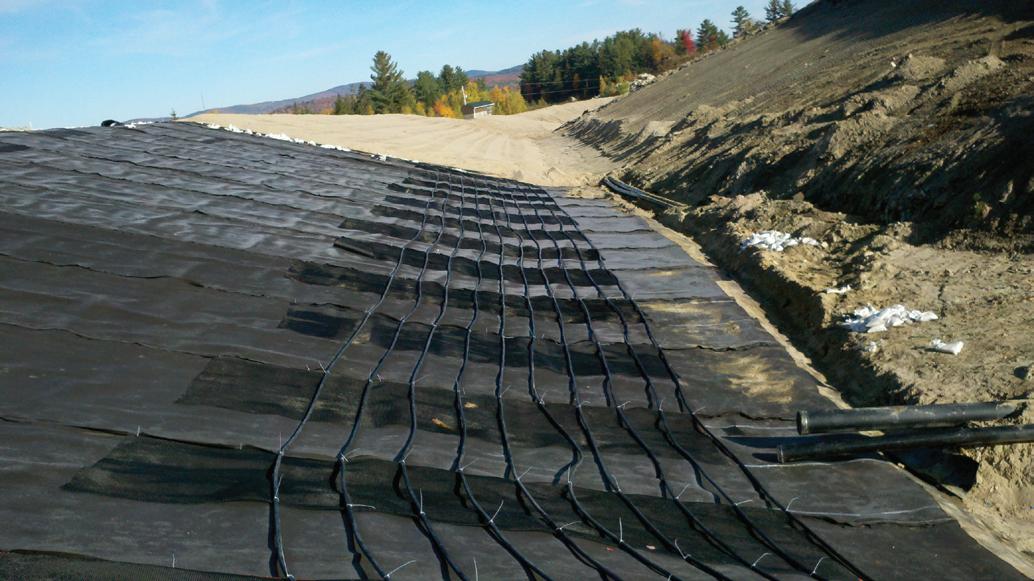
“We understand the concerns posed by some regarding the importation of out-of-state waste, and have voluntarily taken steps to reduce the amount of out-of-state material we accept over the last five years,” according to Oliver.
The other consideration to be made is that modern landfills, for good reason, are now regional in nature when compared to the antiquated “town dump” model of yesteryear. Managing waste based on geographic boundaries instead of utilizing regional resources to improve efficiencies makes little sense in today’s modern society, especially when considering how highly regulated and highly engineered each modern facility is.
While more than 80% of the NCES-bound trash is generated inside New Hampshire, a majority of the out-ofstate waste is contaminated soil used as alternative daily cover, which provides the additional benefit of preserving natural resources such as virgin soils. New Hampshire also benefits by having the ability to export 40,000 tons of recyclables to facilities in Massachusetts, as the state currently lacks the infrastructure necessary to process the materials in-state. Ultimately, by adopting this regional approach, Casella has minimized an emphasis on state — or even community — borders, while accentuating the need for a sound management plan that ensures both environmental protection and fiscal responsibility.

“Creating unnecessary borders on how we manage recycling and waste makes very little sense in a region such as New England, where disposal capacity, recycling facilities and transportation infrastructure are in high demand and short supply,” said Casella Chairman and CEO John W. Casella. “By allowing for shared resources to cross state lines, we can minimize the amount of infrastructure necessary to achieve maximum economic and environmental benefits for the communities we serve. This is not dissimilar from the way most of society operates; it is only when it comes to the end of the supply chain that we question where it began its journey.”
While noting that the infrastructure in place to serve us has long been the target of criticism, regardless of the industry, Casella points out that “none of society’s current solutions to disposing of waste are either completely perfect or completely imperfect, but the goal should always be to limit the potential for risk to public health and the environment, and to continuously improve upon what we know to be true today through sound research and development.”
The modern landfills Casella operates today are vastly different than those of the past, and allows the company to monitor, evaluate and mitigate risk constantly. And, should the initial systems fail, on-site redundancies are in place to ensure that any potential issue remains on-site and does not
harm the external environment surrounding its landfills.
“Operating facilities like these is not without risk, that is virtually impossible, especially when dealing with humans,” Casella said. “But we have developed a culture in our company that, when mistakes happen, we quickly identify them, we quickly address them, and we quickly learn from them so that we do not repeat them. At our core, that is why we have been able to build a successful business. We do not pretend to be perfect, we do not pretend that the work we do is easy, and when mistakes happen we own them and move forward, together.”
Last May, a release of leachate (the wastewater created when rain and snowmelt make its way through the waste mass and into the collection system) occurred when a pump alarm failed, and a storage tank overflowed. However, the redundant systems of the landfill worked to ensure that the overflow was contained on-site and did not penetrate the external environment.
“All of it was captured in an on-site retention pond,” Oliver said. “None of it found its way off-site, and none of it found its way into the environment. We were able to recapture the leachate, dig out the drainage pond and clean it up. While we can all agree that it would have been a better scenario if it never happened, the silver lining is that we were still able to recover from the issue without any harm to others.”
The same measures will be taken at GSL, and because this is a new site, there is significant opportunity to include new technology.
Some residents of Dalton and other nearby towns have voiced concern about the proximity of the landfill to the area’s local recreation area known as Forest Lake State Park. The park is home to a small lake with several camps and vacation homes as well as permanent residences, and is one of New Hampshire’s first state parks, although today it is locally maintained and receives little to no funding from the state.
In addition to a permitting and regulatory process that includes local, state and federal controls, the proposed site for GSL in Dalton also benefits from a natural ridgeline that protects Forest Lake further and is located at a lower elevation than the lake itself. n
The NCES landfill is well-sited, well-run and technologically advanced.In recent years, Casella has grown its business by applying the company’s core values while looking inward to execute a powerful financial and operational strategy. By transitioning to an emphasis on growth via strategic acquisition and development, Casella extended its sustainable practices and approach to new operations.

For the company’s next wave of growth, Casella is looking outward to bring renewed focus and discipline to the way the company engages customers, communities, employees, investors and society. Casella officials expect to sustainably grow the business by increasingly creating and sharing value with external stakeholders.
To craft and deploy this strategy of sustainable growth, Casella has pulled together its customer care, community engagement, marketing, sales, government affairs and sustainability units into a unified team focused on each of the areas where the business interfaces with external stakeholders. Through this focus, Casella is discovering new opportunities to serve each other, serve customers, grow community trust, build shareholder support and improve its impact on society.
Casella’s sustainable growth strategy brings to life the principle of the sustainability handprint. By now, most are familiar with the idea of a footprint quantifying negative impacts on society and the environment. Similarly, the handprint is a summation of positive impacts on society and the environment. Combining the two, Casella officials ask not just how to do less harm but how to do more good?
Sustainable growth is about building a bigger and better business by doing more good, by creating value and sharing it with Casella’s external stakeholders.
Casella has established the following 10 sustainability goals for 2030. Every Casella employee has a role to play in advancing the company’s sustainable growth strategy. >
As Casella manages today’s business and advances toward meeting the company’s 2030 targets, it is equally important to keep our eyes on the horizon, to anticipate change, and to imagine what our employees, our customers, our environment and our society will need from us in the future. This is the essence of sustainable growth.
With the rapidly increasing pace of technological innovation, and the uncertainty of social, economic and environ-
mental change, 30 years into the future is a long time. History — and a healthy dose of humility — tells us that we might only be able to predict a minor percentage of the technologies that will be commonplace in three decades. In a similar vein, we cannot realistically predict the pace or direction of change in markets, infrastructure or culture.
Regardless, we think it’s reasonable to see 2050 as a time when the fundamental forces of change at play today — resource limits, global connectedness, climate change and the pursuit of fairness — will continue to challenge us and in which we will find opportunities. No matter what these forc-


es bring, our job will always be to sustainably manage waste and recyclables, using the best available tools and technologies, so our customers and communities can flourish and the planet remains, well, livable.



We also see 2050 as a time when the definition of waste has shifted and the lines between resources, waste and products blur as the supply chains through which they flow become more circular and expansive. Driving this shift will be innumerable innovations, many of which have yet to be seen. To imagine, invent and deliver these solutions is what excites and motivates us.
Whatever 2050 may bring, Casella will need to nurture the things that make our company great. First, build people; provide a place where people find meaningful work solving vital human and environmental problems. Second, advance human and environmental health by establishing the infrastructure that makes modern life possible and brings society into alignment with natural systems. And lastly, create and share value; be a company that can confidently say that people, communities and the planet are better off as a result of the work we do every day. n
he history of landfills in Bethlehem, NH, and the North Country Environmental Services (NCES) landfill, is the history of technological advances developed over decades to address the ongoing challenges of waste disposal.
Casella took ownership of the property in 1994 and began to set to work in addressing two decades of environmental challenges that previous owners had faced with an ambitious project in conjunction with the New Hampshire Department of Environmental Services.

As part of the development of a new, double-lined landfill cell, DES requested that Casella dig up the entire unlined landfill and put the waste in a double-lined cell that the previous owner had constructed.
At the time new landfill liner requirements went into effect, there were hundreds of unlined dumps and landfills in throughout New Hampshire. Eventually, these unlined facilities were forced to close, but in virtually every case the waste remained in the ground and was simply covered by an impermeable membrane, or a “cap.” This meant that rain and snowmelt couldn’t infiltrate the waste mass, but pollutants in the waste could continue to leach into the groundwater.
“Even though this was not something any other facility in the state had done, and it would be much more cost-effective to simply cap the unlined landfill, we knew that completing the proposed excavation was the only way to prevent further contamination of the soil and groundwater,” according to Casella Chairman and CEO John W. Casella. “We excavated all the waste down to unstained soil and put it in Stage I of the newly constructed, lined landfill.”
In 2010, CYN Environmental was contracted by NCES to excavate iron and manganese precipitate that remained from the previous operations, and completed transferring this material to the lined landfill. Water quality monitoring continues to be conducted three times annually at that site and annually at the Ammonoosuc River, and will continue indefinitely.

In addition to these water and soil mitigation efforts, Casella has also made significant progress in air quality controls. For example, in 1994, only passive flaring of landfill gas existed.


“We have since added a complex and sophisticated system that pulls the gas from the landfill and flares it, which has reduced emissions substantially,” said Casella. “Now, with a cutting-edge facility that will convert landfill gas into clean natural gas scheduled to come online in September 2022, the landfill will become a low-emissions facility.”
Casella also implemented odor controls designed to prevent odor from traveling off-site. Another innovation that originated in Bethlehem, which is being added across other facilities, is the use of “geothermal loops” designed to harness the heat produced by decomposition. That heat is distributed to Casella’s maintenance shop and community greenhouse, eliminating the need for an additional heat source, and reducing the company’s carbon footprint.
In May 2021, Casella and Rudarpa Inc. broke ground on a new Renewable Natural Gas (RNG) processing facility at the NCES landfill. With a planned opening in September 2022, the facility will capture the landfill gas and separate it into marketable gases (primarily methane and carbon dioxide). Converting the landfill gas into transportation fuel is expected to reduce greenhouse gas emissions by an estimated 78,000 tons annually, equivalent to removing more than 15,000 passenger cars from the road.
The RNG facility will also ensure that the NCES landfill will continue to benefit Bethlehem, even after the planned closure of the landfill in 2026.
“In an industry marked by vast and rapid change, the one constant throughout our time in Bethlehem has been our steadfast commitment to the health and safety of Bethlehem’s residents and natural environment,” said Casella. “As the town’s largest taxpayer, we have helped contribute to the economic well-being of the town, while also providing positive economic impact to businesses throughout New Hampshire’s North Country.” n
756,700 POUNDS OF
FROM THE LANDFILL

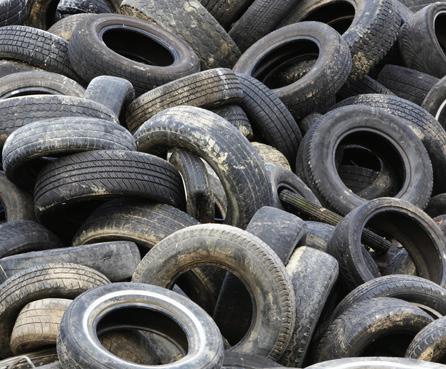
756,700 Pounds of Material Diver
Casella’s recycling programs provide the perfect example of the teamwork required for successful resource management. Households and businesses do their part by separating recyclable materials from their trash, and Casella does its part to collect, sort and process those items into high-quality raw materials for manufacturers to use in new products.

Like any partnership, recycling works best when everyone is committed to playing their individual roles. We live in a closed-loop environment, where everything is connected. An innovative approach to managing today’s waste includes the realization that renewing the life cycle of the products we consume is a critical step in reducing waste. The concept of managing solid waste means giving trash new purpose and a new life. It’s about turning waste into a resource.

From the company’s first recycling center in Vermont in 1977 to its current infrastructure of seven recycling facilities, Casella has been a pioneer in the recycling processing field. Today, Casella is leading the industry with investments in recycling infrastructure, research and development driving the next generation of recycling technologies and innovative recycling programs that are making recycling easier for our customers.

Casella’s primary recycling goal is to produce high-quality materials that manufacturers want for their products. Casella officials take pride in the quality of the company’s recycled material, and to protect it, they’re willing to invest considerable time and energy. This is an essential component of building a thriving recycling industry.
With concern about plastic in the environment at an all-time high, Casella is committed to help solve this monumental problem. The company pledges that all plastics collected on its residential recycling routes and processed in its Zero-Sort recycling facilities will not be shipped to locations outside of North America. Casella is dedicated to establishing new, responsible domestic partners to identify end markets and find a better use for its recycled materials.
Zero-Sort recycling is a single-bin recycling service that helps transform more discarded materials into new products. By allowing residents and businesses to avoid sorting recyclable material, the process becomes easier. Participants just need to focus on filling the bin, and Casella takes care of the rest. Zero-Sort facilities handle many types of recyclables including cardboard, paper, plastic, metal and glass that is baled, remarketed and transformed into new products.
Led by its Zero-Sort recycling facilities, Casella recovers more than 650,000 tons of recyclable materials.


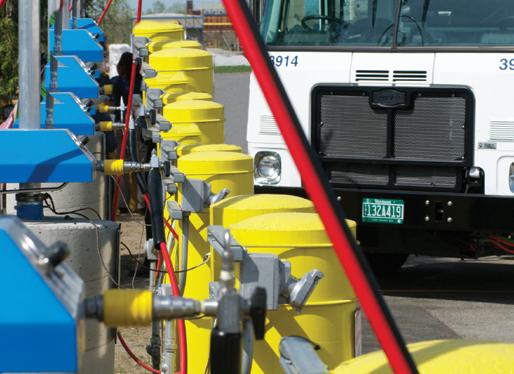
On their journey to zero waste, many of Casella’s customers reach a point where the road gets more difficult. They are recycling cardboard, metal and other traditional recyclables, and have programs in place for food waste. The dominant streams in their waste dumpsters are now items like plastic tubing, wooden reels, film plastics, and packaged food and beverages. It is a collection of materials unique to their business, with no off-the-shelf recovery solution.
Still, many of these items may be quite valuable in the right quantities and the right place. To capture these materials, Casella has established the Aggregation and Recovery Collaboratives (ARC), or Casella ARC Operations. Through the ARC program, local organizations are brought together to establish practical resource recovery operations tailored to their unique needs.
The first Casella ARC operation was developed in Lebanon, NH, with Hypertherm, a manufacturer of industrial cutting systems. The operation has helped to increase their recycling rate from 43% to over 97%, while also enabling innovative recovery solutions through risk- and reward-sharing, aggregation and densification technologies, and efficient access to reuse and recycling markets. The model can be tailored to handle any combination of materials, allowing for the recovery of numerous items that were previously considered “unrecoverable.” Although these items are often lightweight, they have high embedded energy, carbon and other resource value, and are highly worthwhile to recover.
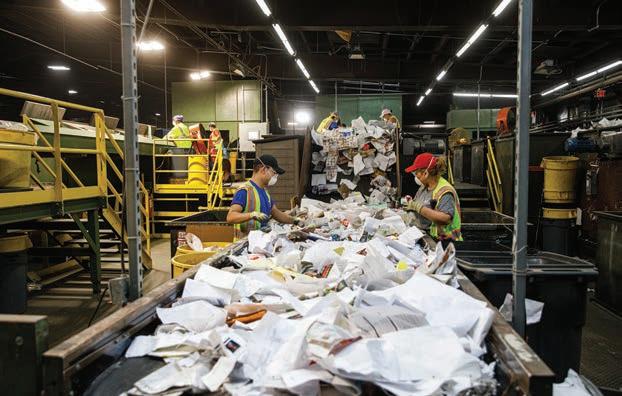
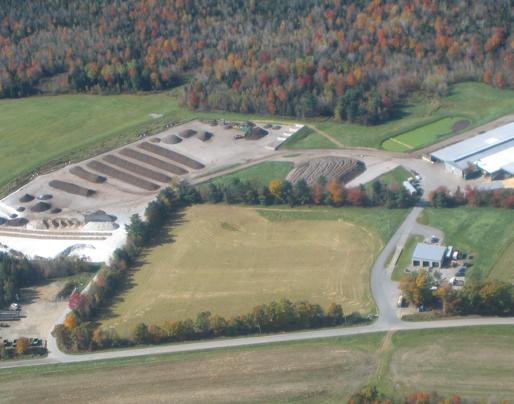



Establishing a successful Casella ARC operation requires very close collaboration among the partnering stakeholders. Casella brings expertise in logistics, handling, processing equipment and commodity markets. Generator partners bring a commitment to waste reduction, volumes of recyclable items and, in some cases, tangible assets such as equipment, vehicles or warehouse space. Most importantly, all partners contribute a willingness to work together to create enduring solutions to serve their unique local materials recovery needs.
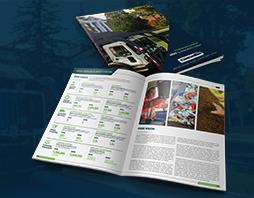
Casella’s Resource Solutions segment unites the company’s recycling, organics and customer solutions business units, delivering an efficient resource to help customers meet their waste and recycling goals. Beyond this, the group executes the strategy of sustainable growth as a powerful driver of new business, a builder of talent and an engine of innovation.
With the Resource Solutions team, Casella is able to deliver more services to current industrial, institutional, commercial and municipal customers. Beyond traditional waste and recycling services, Casella provides specialty recycling, organics recovery and advanced resource management services. This holistic approach positions current customers to achieve their sustainability goals and draws new customers.
To successfully deliver complex resource management services, Resource Solutions has fully embraced Casella’s strategic commitment to the growth and development of its people. Customers entrust their sustainability programs to Casella, because they trust the company to bring a depth of knowledge and the leadership skills to champion sustainability goals and manage complex organizational change.
Sustainability requires strategic innovation and execution. The most fertile ground for innovation is the space where Casella’s expertise overlaps with the expertise of its customers. Immersed in their customers’ operations, the Resource Solutions team is constantly inventing practical solutions to real world problems, and rapidly advancing the technologies and capabilities of sustainable resource management.
Casella retrofits its Charlestown, MA recycling facility, bringing 750 tons per day of single-stream capacity to greater Boston. The company also issues its first Sustainability Report. Casella builds its first landfillgas-to-energy power plant in Casella begins to build Resource Solutions, extending professional services to customers across 45 states. Casella positions for Sustainable Growth, broadening ESG communications and announcing ten strategic sustainability goals for 2030 Casella launches its first food waste collection route. Two years later, it completes the strategic acquisition that would become Casella Organics, making it a leader in biosolids management.
Casella doesn’t manage resources in a vacuum. Instead, the company partners with numerous entities — both private and public — to support New Hampshire’s waste hierarchy model, promoting waste reduction, reuse and recycling. The following six examples highlight the scope of services the company provides to help customers meet recycling and sustainability goals. Altogether, Casella helped New Hampshire customers recycle more than 5,000 tons in 2021.
Casella provides Bethlehem (population 2,500) with several critical services to advance waste reduction and recycling. These services include a free curbside, single-stream recycling service, as well as drop-off locations for electronics, metals and tires, and an annual household hazardous waste collection day, which collectively allowed residents to capture 378 tons of recycled material in 2021.
As businesses approach zero-waste standards, they often reach a point where they’re capturing all standard recyclables and need to invest in specialized recycling services. In 2018, Hypertherm, an industrial manufacturer, approached Casella to achieve their zero-waste goals. Recognizing that consolidation would be required, the partners secured warehouse space on the Hypertherm campus, and Casella hired staff to sort, segregate and process materials.
By consolidating materials, the program had an immediate impact on Hypertherm’s sustainability goals. This set the stage for an Aggregation and Recovery Collaboration, known as the Casella ARC model. To fully leverage Hypertherm’s warehouse, Casella began sourcing recyclables from other customers with hard-to-recycle material.
Today, Hypertherm’s recycling rate exceeds 98%, and the ARC model enables nearly 1,000 tons per year of recycling for customers throughout the region. Casella has since utilized this model as a successful service standard and replicated the approach in other Northeast markets.
In recent years, Bethlehem’s recycling rate has ranged from 27% to 34%. With the addition of new services, Casella officials expect those numbers to continue to rise. The company recently partnered with a regional veteran-owned business, Apparel Impact, to add textile recovery to the town’s services. The program provides a drop-off bin for residents to donate used clothing. Bethlehem also hosts the North Country Environmental Services landfill and Casella’s new recycled natural gas facility.

Phillips Exeter has been a collaborator with Casella for six years, advancing the campus’s recycling needs and sustainability initiatives. Casella services helps the school capture single-stream recycling, compost, wood, metal, e-waste and donations, recovering nearly 250 tons per year from the disposal stream. In the 2021 academic year, Phillips Exeter achieved a 49% recycling rate.
To minimize contamination (non-recyclable items) in the recycling stream, Casella supports the campus’s grounds crew through its Recycle Better program, providing training, consistent signage and ongoing communication. Efforts have included education to keep out plastic bags, which serve as a problematic contaminant at most academic campuses. “Green Move Out” days, held in conjunction with Goodwill, collect goods for donation and reuse.
In 2021, Casella installed compactor-monitoring technology that enables the service team to optimize load sizes, cutting costs, fuel consumption and emissions. The compactor monitor is analyzed remotely, and preliminary results show it has cut fuel emissions by 49%, saving over 400 gallons of fuel over six months.
In 2016, Casella and Coca-Cola Northeast began a collaborative journey rooted in sustainability to get Coca-Cola’s Londonderry bottling plant to zero waste. Together, the two organizations improved the facility’s material management program to attain a recycling rate of over 90%. Since the initial partnership launch, Casella has expanded its services to manage all of the Coca-Cola facilities throughout the Northeast, including two New Hampshire locations in Belmont and Londonderry, recovering hundreds of tons of material from these plants each year.
Casella and Coca-Cola have worked on recovering recyclable commodities collected throughout the plant, as well as managing non-salable, fully packaged goods to better use. Casella’s depackaging capabilities for the non-salable products separate the liquid material (sodas, juices, etc.) from the packaging (PET bottles, aluminum cans, etc.) with both streams being recovered and diverted from disposal. In 2021, these efforts have led to the recovery of over 570 tons of recycling.
With a population of roughly 7,500, Stratham is serviced by Casella’s hauling division in Salem. The town currently recycles nearly 1,000 tons per year, with an estimated recycling rate of 30%. To increase the community’s recycling efforts in 2021, residents transitioned to automated collection services. Automation improves efficiency and safety, and the shift to wheeled carts improves recycling by increasing participation, reducing litter and keeping recyclables dry.


To support the project, Stratham secured a grant from the Recycling Partnership for carts and education. The carts contain 40% post-consumer recycled content, which is among the highest in the industry. The project communication strategy also included a multi-year Recycle Better education campaign to improve recycling quality by ensuring residents understood curbside collection programs and only recyclable items are placed in bins.
Seabrook, in partnership with Casella, has created significant environmental value by composting wastewater bio-solids at the Hawk Ridge Compost Facility in Unity, Maine. Wastewater bio-solids are often overlooked in the municipal solid-waste stream, but the total number of tons can be significant, as are the environmental benefits of transforming them into high-quality compost.
The Hawk Ridge Compost Facility uses fully enclosed composting that provides 100% process control, enabling Casella to produce consistent compost. After the active tunnel compost phase, the compost is aged for three months, then screened and purchased by local soil professionals, landscapers, golf courses and nurseries to improve soil organic matter, water retention and nutrient levels. Composting a total of 1,800 tons per year of bio-solids, Hawk Ridge has an estimated annual greenhouse gas benefit of over 860 metric tons of CO2e, the equivalent to taking more than 180 cars off the road. Seabrook’s decision to recycle bio-solids helps recover valuable organic nutrients, rebuild and replenish soils and protect the climate.
Located in Concord, St. Paul’s School has been a Casella customer for more than five years. Through this collaboration, Casella has helped the institution advance its sustainability goals, while recovering nearly 100 tons of recyclables and organic materials in 2021.
St. Paul’s School is the recipient of Casella’s 2021 Sustainability Leadership Award, honoring the school for its commitment to resource sustainability, as well as its ongoing dedication to creating a brighter future.
“It gives us a sense of great pride to honor our customers for their outstanding work in advancing sustainability,” said John W. Casella, Casella’s chairman and CEO. “We hope that by bringing attention to their efforts, others will be inspired by their passion, commitment and success.”
One of St. Paul’s most innovative initiatives is the implementation of Grind2Energy technology to recover campus food waste for anaerobic digestion. The equipment, installed in March 2020, was a first in New Hampshire, making St. Paul’s the first high school anywhere to adopt the technology. The cutting-edge G2E technology has proved to be an ideal fit for the institution’s operations, campus aesthetics and sustainability mission, helping to find a purpose for large volumes of on-site food waste.
Each month Casella provides St. Paul’s School with a diversion report that summarizes electricity generated and emissions saved due to the G2E system. The data is then shared with students and staff. Since 2020, St. Paul’s School has captured over 100 tons of food waste, generated 9,930 kilowatt-hours of power, reduced carbon emissions and extracted 3.1 tons of fertilizer. n
